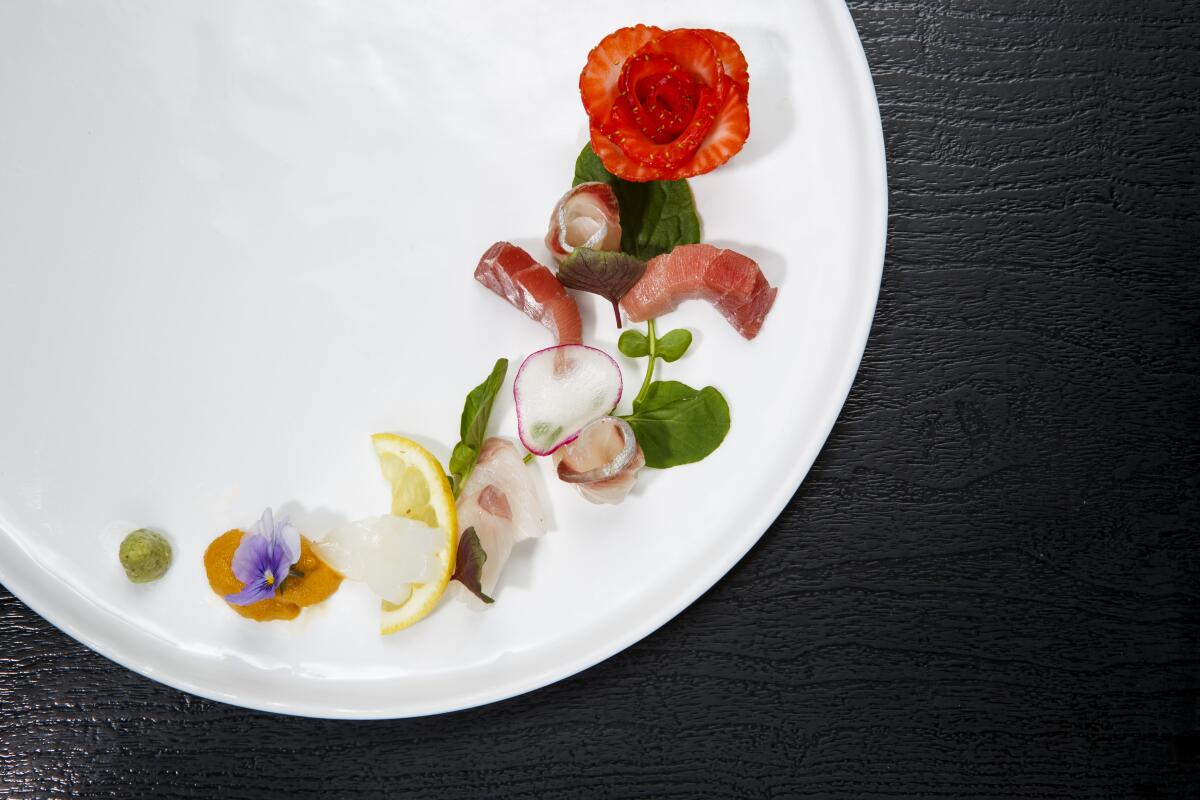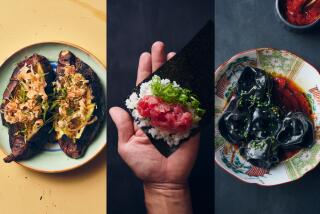Review: An E-ticket meal at n/naka

- Share via
The first time you come to n/naka, a kaiseki restaurant a bit north of Sony studios in the Palms area of Los Angeles, you will inevitably soar right by the place, a low, featureless building in a strip of dry cleaners and tarot-card readers surrounded by a raked zen garden in 50 shades of gray. There is no sign, no valet parking, no hint that you are entering a restaurant instead of a high-toned back office.
When you find your way through the front door, you will be greeted by name — reservations are mandatory — and led through the spare, elegant dining room to a serene private room or possibly a nook that looks like the sleeping alcove in an expensive Manhattan studio apartment. On your table will be another zen garden, an arrangement of gray pebbles and a single, sea-washed stone. You are not, it goes without saying, at Katsuya.
Eat your way across L.A.
Get our weekly Tasting Notes newsletter for reviews, news and more.
You may occasionally receive promotional content from the Los Angeles Times.
If the convivial gastropub has been the model for what seems like two new restaurants out of three in Los Angeles, it is the idea of Japanese kaiseki — exquisite meals of many small courses designed to express the mood of a season and a place — that has lately been driving the ambitions of the world’s best chefs, up to and including Ferran Adrià. The onsen egg, soft-boiled at low temperature for long periods of time, an art originally perfected in the volcanic hot springs of Japanese ryokan, is as close as there is to an emblematic dish of global haute cuisine at the moment.
Michael Cimarusti’s tasting menus at Providence echo the rhythms and the flavors of kaiseki more closely than they do anything you’d find in France. Sometimes it seems as if David Myers shut down Sona in order to study kaiseki cuisine. Urasawa, while often thought of as a sushi restaurant, basically serves kaiseki meals with an extended sushi course toward the end. It is hard to find a serious kitchen in town now whose menu does not change each week according to the whims of the farmers markets, whose menu does not include the occasional wisp of raw fish or wash of ponzu in the course of a tasting menu, whose chef does not adjust his or her plating to reflect the cycles of nature.
So, it is almost startling to realize that n/naka may be the first dedicated kaiseki restaurant in Los Angeles, at least the first outside the Japanese expatriate community, and that the sheer level of cooking in this modest bungalow eclipses what you find in grand dining rooms whose chefs appear in national magazines. Consider: diver scallops grilled in their shells and presented with shiitake mushrooms, a hint of yuzu zest and their own chewy livers; a fillet of crisply seared sea trout arranged around roasted cherry tomatoes and a lab pipette filled with reduced ponzu; freshly made green tea-sesame tofu on top of which is arranged an ikebana of lobster knuckle, sea urchin roe, a twinkle of gold leaf and a pansy the chef picked from her backyard garden that morning.
The chef is Niki Nakayama, a slight, graceful woman who worked at Mori Sushi after she attended culinary school in Pasadena and cooked at a cousin-owned ryokan, a Japanese country inn known for its kaiseki meals, before returning to California to make sushi at Azami, a Melrose sushi bar known for its team of female chefs. Before opening n/naka, she established the organic garden in her Arcadia backyard from which the restaurant gets many of its vegetables and herbs. It is occasionally difficult to ascertain whether the most impressive bit of a dish is the chewy slab of Japanese halibut fin or the thimble-sized cucumber used as garnish, whose texture has been transformed into something almost luxurious through a hundred tiny slashes of her knife.
Nakayama uses lots of Western touches — you may see Monterey Bay abalone simmered in a clear broth, or you may see it tossed with spaghettini, pickled cod roe and shaved summer truffles, an ingredient she uses a lot this time of year. But there is a stillness to her cooking, a sense that the Asari clams, baby fennel and asparagus are together not to make a chef-ly statement but because it is the day that they go together best. Where someone like Nobu Matsuhisa puts his stamp on every dish — you never take a bite at Nobu you don’t realize is his — Nakayama steps out of the way of her ingredients, even in concoctions as seemingly baroque as o-toro tartare with sea urchin, American caviar and pungent dribbles of reduced dashi.
Nakayama does cook with way more bluefin tuna than any conscientious chef ever should. As good as it tastes, the species has been hunted nearly to extinction.
But it is fascinating how a course of fried pompano fillets served with sautéed peppers and chips of their deep-fried bones — you tuck them into lettuce leaves and dunk them into bowls of sweet-sour vinegared broth — can resemble the Hong Kong-style dish of flounder with crispy skeletons, recall the flavors of Sicilian seaside cooking and be eaten like Korean ssam, but still seem purely Japanese.
For the month of June, Nakayama is also running a foie gras tasting menu, probably because with the imminence of the July 1 ban it is suddenly, desperately, in season and also because she likes using the liver anyway: frozen and shaved over tofu, poached and flavoring soba, grilled and served with duck. I found it fairly astonishing how easily she integrated the liver into almost every course of the menu, as an egg custard with truffles, crumbled over amberjack sashimi, poached in dashi with abalone, seared and made into sushi, and laid over unagi “risotto,” without becoming obtrusive or overrich. A dish of seared eel interleaved with melting slices of foie gras torchon, drops of jellied yuzu juice and halved figs that had been caramelized with a blowtorch was especially splendid, recalling the famous eel-foie gras dish of San Sebastian chef Martin Berasategui, but becoming something wholly new.
This is probably the place to point out that dinners at n/naka are quite expensive. The unit of consumption is either the nine-course $110 chef’s tasting menu or the 13-course $165 modern kaiseki menu — which inevitably includes an extensive sashimi course with freshly grated Japanese wasabi, several courses of sushi and a Wagyu beef course in addition to the sort of dishes we’ve mostly been discussing here. The wine and sake pairings, well-chosen by sommelier Jeffrey Stivers, run $55 to $85 per person on top of that. (There is also a vegetarian menu.) Is it worth it? One person I took ended up taking her husband back to the restaurant three evenings later. When you’re up for an E-ticket ride, sometimes only an E-ticket ride will do.
n/naka
A kaiseki restaurant in unassuming environs, where chef Niki Nakayama prepares exhilarating Japanese tasting menus.
Location: 3455 S. Overland Ave., Los Angeles, (310) 836-6252, https://www.n-naka.com
Prices: Set-course menus only, $110 to $165.
Details: Dinner, by reservation only, 6 to 9 p.m. Tuesday to Saturday. Credit cards accepted. Beer, wine and sake. Limited lot parking.
More to Read
Eat your way across L.A.
Get our weekly Tasting Notes newsletter for reviews, news and more.
You may occasionally receive promotional content from the Los Angeles Times.










